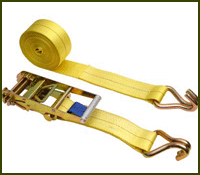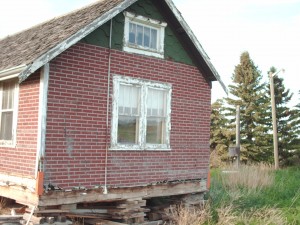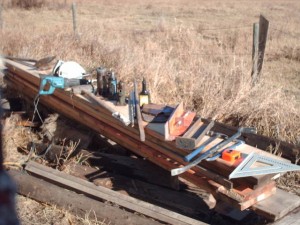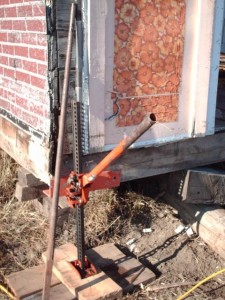In my last post, I was talking about house moving. There is a whole segment of residential construction referred to in several ways. “Modular homes”, “Manufactured homes” and “Mobile homes”. These terms describe any home which is manufactured somewhere other than where it is to be lived in – usually a factory. The house is moved onto it’s final location after it has been purchased. Some assembly required. Batteries not included.
If you want to move a conventionally constructed home, your not going to find it as easy as moving a mobile home. The Old Brown Cottage -OBC for short – is the what I call the building in the pictures below. The family that lived in the OBC was, you guessed it, the Brown family. husband and wife raised two sons in a house about 500 square feet. There was no plumbing except for one sink with hot and cold water. The wife, so the story goes, was the one to plant all the lilac bushes around the property, and god bless her for it. The landscaping is what makes the property. I thought ‘now here is a real heritage building’. It’s not that old -1940, and not fancy at all. So why save it? I thought it would be easier to move the building that to tear it down and dispose of the resulting mess. I’m sure I made the right choice, but there are those who think I should still tear it down.
The plan was to get some telephone poles and make a raft of logs that the house would sit on. I jacked the house a little and made slots in the foundation. I then used my brother’s tractor to slip the telephone poles under the building and through to the other side. After the poles were in place I begged, borrowed and bought as much chain as I could. Each pole was wrapped and linked to the next one. Then I got the Rainbow Hutterite Colony involved. They brought down a John Deere 9400 tractor to pull the house out of the way (my brother’s tractor was too small). I said to Joe, the Hutterite driving the tractor “So, are you sure this little thing can pull that?” I was joking and he started to laugh. He said “This tractor could pull ten of those buildings all together. I don’t think they took the Machine out of idle speed when they dragged it off the old foundation. I had used only an 8 tonne jack to raise the corner of the building for the telephone poles.
The house is now in it’s new/final resting place at the SE corner of the yard. The goal now is to level the building and get a foundation under it. It will have a perimeter foundation of piers on which will be beams. These beams will hold the floor joists level. The existing floor joists are badly damaged from all the dragging, shoving and skidding that was done to the building. I got some rough sawn 2×8 boards from Gap Creek Lumber in Sundre, AB. The tools are lined up on the boards. I chose rough sawn lumber because it will match the dimensions of the existing lumber on the building. You often have to check the lumbers actual dimensions when doing heritage restorations. Even newer buildings in rural parts of the country will use rough sawn lumber since it’s cheaper and can be obtained locally. Today the family run saw mills are being chased to death by government regulations.
What else have I got? Five jacks: 2 tonne hydraulic bottle jack, 6 tonne hydraulic bottle jack. 10 tonne hydraulic bottle jack, Two 2 tonne Jack-all jacks (shown in position below), Makita Reciprocating saw, sledge hammer, large crow bars, rafter’s square, and various pieces of thick steel such as “L”, “U” shaped, flat and beam shapes. One thing not shown is a couple of big 8 tonne straps that you see holding down loads on big tractor trailer units on the highway.

If I had to travel light and jack a building I’d take my 10 tonne bottle jack, one flat steel plate for under the jack, my beam steal that I made for jacking, my largest pry bar and my large nail puller/pry bar.
I need lots and lots of blocking. Hardwood is best for blocking since it’s denser and will not cruch or compact when the house is set down on it. Most mobile home movers bring an pickup truck full of poplar 4x4x36 inch blocks.
When I start jacking, I go slow. Steel foot pad and especially a steel support over the ram of the jack are needed. I try to span a couple of joists with the steel support. I Jack a little and listen. Where is the creaking and cracking coming from? Wood is quite flexible when it has to be. As an example my antique office chair has creaked and cracked for 12 years now but is far from coming apart. I Never place any body part where it could be pinched if the jack failed. As I gain a couple inches, I place blocking in a strong area of the building, but somewhere that won’t be in the way of my next jack position. This way, if something gives out, I’ve only lost less than 2 inches at any point. At any rate the jacks only go so far before they are “maxed out” for height. Jack-alls have the greatest range but the least amount of lifting power.
When I block the building and release the pressure, the house comes back down several inches. the blocks will be compressed into the earth and it seems that you only get half of the jacks lift out at the end. Re-set the jack and start again for anther few inches.
Check back next month for more pictures and story about the Old Brown Cottage.



